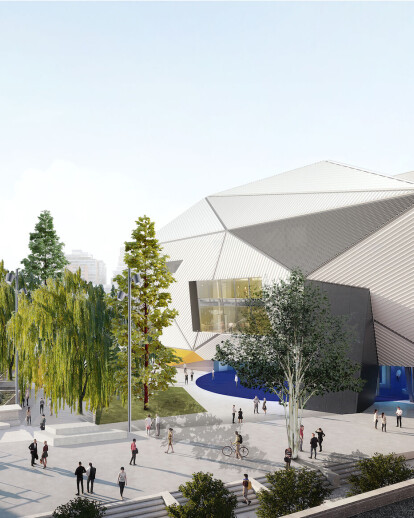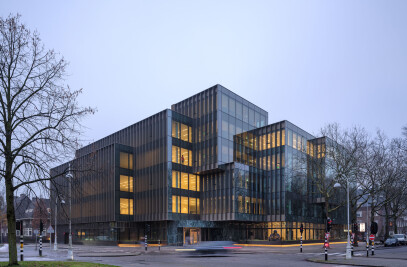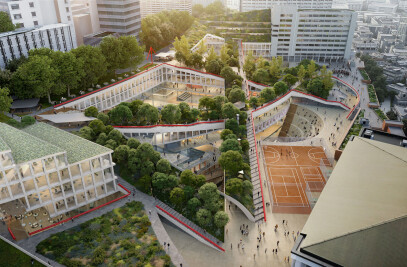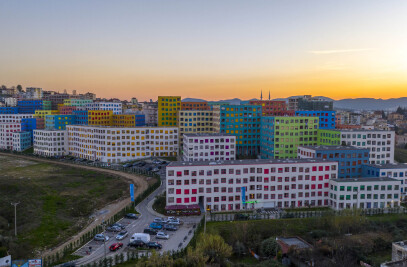Aviva Studios, which will be programmed and operated by Factory International, embraces Manchester’s industrial as well as its creative past. The building’s concrete and corrugated metal facades stand against the refurbished brick warehouses and new build flats, offices, and television studios that make up the new St. John’s neighbourhood.
The building’s main event space, the Warehouse, is conceived as one large industrial space, left bare to be adapted by its users as they see fit. The arches that once supported the historic viaduct known as the Pineapple Line are preserved as part of the foyer. A technical grid on the Warehouse ceiling permits any type of use, from concert to exhibition. A movable full-height acoustic wall, 21 metres tall, can divide the space so that two events can coexist without disturbance. The space can be opened up, but also split and a performance space made larger or smaller.
The Warehouse is complemented by the Hall, a 1,600-seat auditorium with a flexible stage, adaptable to ballet, theatre, music, and cross-art performances. The Warehouse and the Hall can work in tandem: the proscenium opens fully into the warehouse and allows the stage to run deeper into the building.
It is a space that can create multiple opportunities and endless configurations and environments. It will be a new type of performance space, a unique crossover between a fixed theatre and flexible warehouse.
At street level, the design has allowed the creation of a significant area of public space along the River Irwell.
This landmark new cultural space currently being built in the heart of Manchester, UK, is one of the largest and most ambitious developments of its kind in Europe. Aviva Studios is designed by world-leading practice Office for Metropolitan Architecture (OMA), with OMA Partner, Ellen van Loon as lead architect, and is their first major public building in the UK. The development is being led by Manchester City Council, with backing from HM Government and Arts Council England. Factory International will operate the cultural centre, as well as delivering the citywide Festival every other year.
Located in the centre of Manchester along the River Irwell, Aviva Studios forms part of the city’s major St. John's Quarter redevelopment. The site is part of the Castlefield Conservation Area, which includes the Science and Industry Museum located on a globally significant industrial heritage site including the world’s oldest surviving passenger railway and world’s first railway goods warehouse. The redevelopment scheme will revive the entire site of the former Granada TV Studios, which is being transformed into a burgeoning city centre hub for culture, creativity and digital innovation.
Key Milestones
• November 2015: OMA selected as winner of the international competition to design The Factory. The project marks OMA’s first major public building in the UK.
• 8 July 2017: Ground-breaking Ceremony with performance by Laurie Anderson for Manchester International Festival.
• July 2021: Deborah Warner’s installation Arcadia takes place within the construction site of the building as part of Manchester International Festival.
• June 2023: The venue welcomes its first visitors.
• October 2023: Official opening production for Aviva Studios, the home of Factory International.
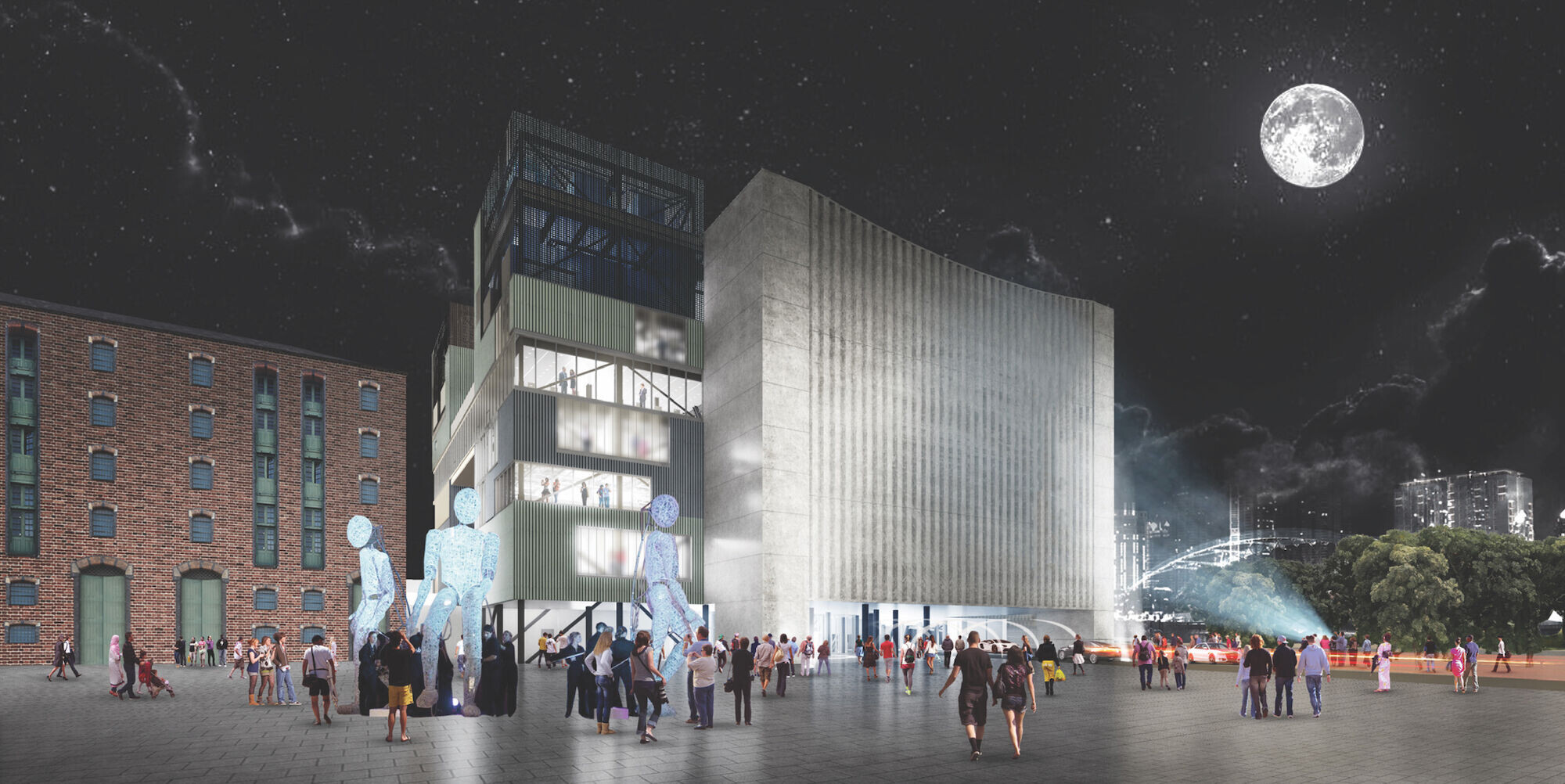
Materials
Throughout the project’s interior and exterior, the focus of material selection was to reflect the industrial nature and heritage of the site. The combination of exposed steel connections, raw concrete, and façade systems typically used on industrial buildings and factories are brought together to create a new interpretation of the materials, while retaining the industrial aesthetics.
Features
The design of the building is based around large, open, flexible spaces that will constantly change and reconfigure to meet the needs of the work created and presented in the building. Key elements include:
Warehouse: 30m wide, 65.65m long, 21m (clear) high, the Warehouse is the ultimate flexible performance space, with a theatre grid spanning the entirety of the area. At 21 metres tall, it is higher than four double decker buses stacked on top of each other and is the length of a Boeing 747 aeroplane. Two ‘Multiwalls’ enable the Warehouse to be configured as a single space or divided into two warehouse spaces. The Multiwalls move as individual panels that are manually moved around a track. 170 strong points in the Warehouse can each hold 1 tonne, to allow sets, production rigs or performers to be suspended from the walls, and the standing-height grid has a working load of 200T, evenly distributed across it.
Truck Lift:
On the West side of the North Warehouse is a unique, purpose-built vehicle lift that allows for two 50-ton articulated lorries, with trailers up to 40 feet long, to access the Warehouse.
Hall:
Two foyers with bars, fixed seating at the balcony for 640, flexible stalls for multiple seated (max 1,380) and standing configurations and flexible orchestra pit with a capacity of 80 positions. At 19 metres wide and 5.5 metres deep, this stage can also be expanded to 8 metres deep and 21 metres wide, or reduced to 2.5 metres deep. The Proscenium steel shutters give the ability for simultaneous events to take place in the Hall and Warehouse. They create a sound separation between the two spaces.
The Warehouse and Hall can be connected into one flat floor space, with the ability to act as a 35 by 32 metre stage for the Hall, with an 11 metre high proscenium arch opening.
Back of House Towers: Support including offices, a green room and dressing rooms (9 in total which can accommodate 95 people).
Social: This is a primary foyer facing Water Street serving both the Hall and the Warehouse. It is framed by eight Grade II listed railway arches at the south. There are three entrances into the space, City Square to the North, River Square to the West, and a direct link into the Science and Industry Museum (SIM) lower courtyard through a Grade II listed arch. When SIM is open people can seamlessly move between the spaces.
A 33-metre-long bar is split in two by the ‘mega pig’ which is a key part of the building’s structural engineering, holding up the proscenium arch above. Additional multi-use foyers are on Level 2 and Level 3 of the building.
Outdoor spaces: New outdoor spaces will provide visitors with a setting to enjoy the building and surrounding environment, including the River Irwell – an almost unique experience in central Manchester. A number of trees will also be planted.
Environmental Sustainability
Factory International is on a committed path towards zero-carbon activity. Using operational data from 2024 as the benchmark, Factory International’s ambition is to become a zero-carbon emissions organisation by 2038 in line with Manchester’s targets. The capital project has invested significantly in the building fabric to create acoustically insulated spaces enveloped in a very high thermal mass which reduces the amount of energy required for heating, and high-performance glazing also reduces the amount of energy required for cooling. The fresh-air ventilation system closely monitors the air quality in the building to match the flow rate with the occupancy to minimise energy consumption and maintain comfort for each size of event. Waste heat is also recovered. The building is targeted to achieve a BREEAM (Building Research Establishment Environmental Assessment Method) assessment rating “Very Good”. A BREEAM rating is generated by measuring and grading projects against 103 different sustainability criteria covering the management of the project, materials and delivery.
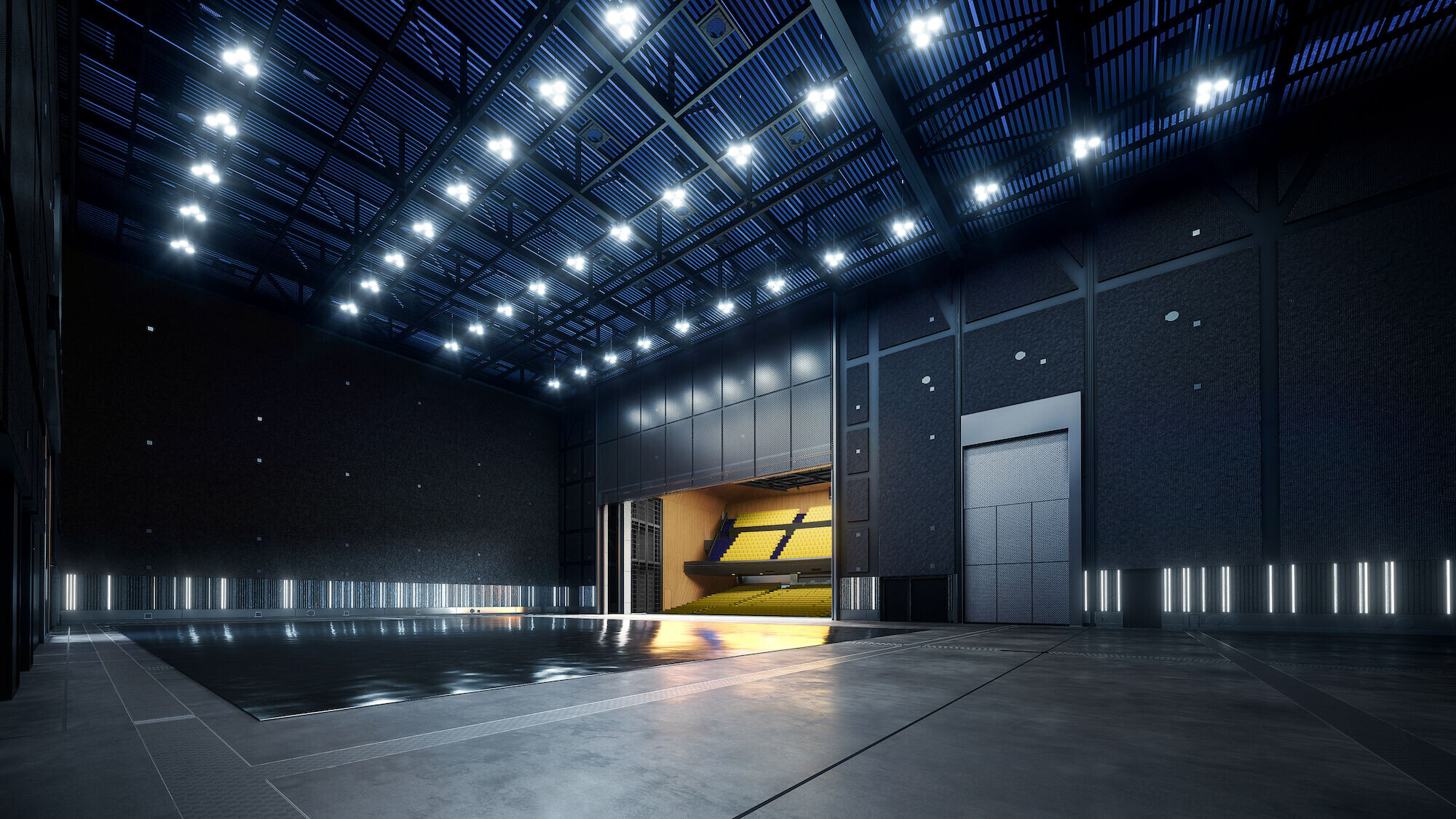
Team:
Architect: OMA Technical Architects: Ryder Architecture Construction Partners: Laing O’Rourke Structure and Civil Engineer: Buro Happold Services Engineer: Buro Happold, BDP Acoustic Engineer: Level Acoustics Fire Engineer: WSP Stage Engineering: Charcoal Blue Vertical Transportation: Pearson Consult Landscape Design: Planit.IE IT: Turner & Townsend Transport Planning: Vectos
OMA Team: Ellen van Loon, Rem Koolhaas, Gary Owen, Carol Patterson, Jonathan Telkamp, Richard Hollington, Tanner Merkeley, Jacopo Bellina, Paloma Bule, Anita Ernődi, Marc-Achille Filhol, Alain Fouraux, Benedetta Gatti, Aris Gkitzias, Michael Hadjistyllis, Jason Houssein, Lisa Huang, Aleksandar Joksimovic, Hans Larsson, Thijs van der Lely, Emma Lubbers, Dirk van der Meij, Felix Morczinek, Tom Paling, Maria Aller Rey, Mario Rodriguez, Helena Rong, Won Ryu, Saskia Simon, Lukasz Skalec, Wael Sleiman, Iason Stathatos, Koen Stockbroekx, Shinji Takagi, Nicola Vitale, Federike Werner, Tom Xia, Yushang Zhang.

